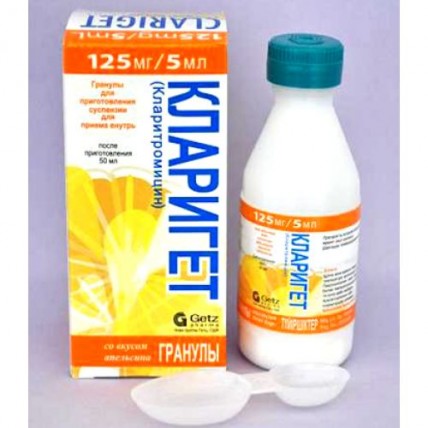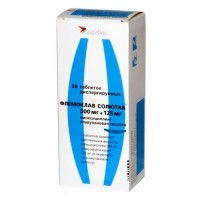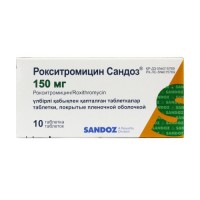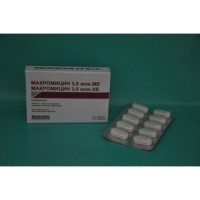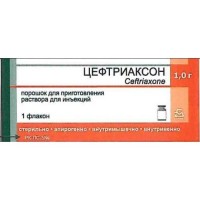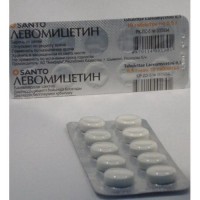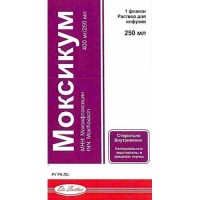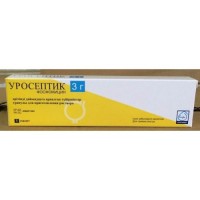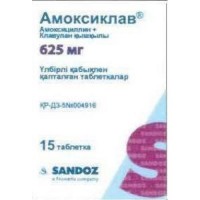Klariget 125 mg / 5 ml, 38.5g of granules for oral solution
- $29.50
The instruction for medical use
of Klariget Torgovoye medicine
Klariget
Mezhdunarodnoye's name the unlicensed
name Klaritromitsin Lekarstvennaya
the Granule form for suspension preparation, with taste of orange, 125 mg / 5мл
Structure
of 5 ml of drug contains
Active agent: the klaritromitsina of a granule 454.545
(it is equivalent to a klaritromitsin) 125.000
Excipients - sucrose, the titan dioxide (E 171), aerosil 200,
xanthane gum, methylparaben, was afraid powder (fragrance with taste of orange)
the Description
of the Granule from white till almost white color.
Pharmacotherapeutic group
Antibacterial drugs for system use. Macroleads,
linkozamida and streptogramina. Macroleads. Klaritromitsin.
The ATX J01FA09 code
Pharmacological action
Pharmacokinetics
At intake Klaritromitsin is quickly soaked up from digestive tract, bioavailability of 50%. Food slows down absorption, significantly without affecting bioavailability.
Tmax at intake on a hungry stomach is reached during 2–3 h. Contacts proteins of blood plasma of 50%. About 20% of the accepted dose are oxidized in a liver with formation of the main metabolite of a 14-hydroksiklaritromitsin at once (14-ON-klaritromitsin) which has the significant antimicrobial activity concerning Haemophilus influenzae. Biotransformation is catalyzed by enzymes of tsitokhromny P450 complex. Stable concentration of a klaritromitsin and its main metabolite are reached within 2–3 days. At reception of 250 mg of a klaritromitsin each 12 h Cmax of a klaritromitsin in an equilibrium state makes about 1-2 mkg/ml, Cmax 14-ON-klaritromitsina — 0.6-0.7 mkg/ml, at reception of 500 mg each 12 h Cmax of a klaritromitsin — 2–3 mkg/ml, each 8 h — 3–4 mkg/ml, for 14-ON-klaritromitsina Cmax at reception of 500 mg each 8–12 h — to 1 mkg/ml. Klaritromitsin and 14-ON-klaritromitsin well get into liquids and body tissues, including into lungs, skin, soft tissues. Distribution volume — 243–266 l. T1/2 of a klaritromitsin at reception of 250 mg each
12 h — 3–4 h, 14-ON-klaritromitsina — 5–6 h, at reception of 500 mg each
8–12 h T1/2 value of a klaritromitsin and its main metabolite increase to 5–7 h and 7–9 h respectively. It is removed by kidneys and with excrements. With urine in not changed look — 20–30% or 40% at reception in the form of suspension and in the form of 14-ON-klaritromitsina 10-15%. About 4% are removed with excrements. Abnormal liver function. In an abnormal liver function the equilibrium concentration of a klaritromitsin did not differ from those at patients from the liver kept by function whereas equilibrium concentration
14-OH klaritromitsin at patients with an abnormal liver function were much lower. In an abnormal liver function the reduction of removal of medicines in a look 14-ON-klaritromitsina is partially compensated by increase in removal of a klaritromitsin kidneys and dose adjustment is not required. Renal failure. Patients with renal failures have a concentration of a klaritromitsin in plasma, T1/2, Cmax and Cmin, AUC of a klaritromitsin and 14-ON-klaritromitsina raise. At patients with a heavy renal failure (at creatinine Cl less than 30 ml/min.) dose adjustment can be required.
Klariget's pharmacodynamics is a semi-synthetic makrolidny antibiotic with bacteriostatic action. Klariget contacts a 50s-subunit of a ribosome of bacteria, causing suppression of protein synthesis of bacteria.
Klaritromitsin is effective concerning many microorganisms, including intracellular (Mycoplasma pneumoniae, Legionella pneumophila, Chlamydia trachomatis and Chlamydia pneumoniae, Ureaplasma urealyticum), gram-positive — Staphylococcus spp., Streptococcus spp. (including Streptococcus pyogenes, Streptococcus pneumoniae), Listeria monocytogenes, Corynebacterium spp., and gram-negative bacteria (Haemophilus influenzae, Haemophilus parainfluenzae, Haemophilus ducreyi, Moraxella catarrhalis, Bordetella pertussis, Neisseria meningitidis, Borrelia burgdorferi, Pasteurella multocida, Campylobacter spp., Helicobacter pylori), some anaerobe bacterias (Eubacterium spp., Peptococcus spp., Propionibacterium spp., Clostridium perfringens, Bacteroides melaninogenicus), Toxoplasma gondii, Mycoplasma pneumoniae, mycobacteria (Mycobacterium avium complex including Mycobacterium avium and Mycobacterium intracellulare, also M.marinum, M.leprae). The majority Methicillinum - and oksatsillinrezistenty strains of stafilokokk are not sensitive to a klaritromitsin.
Indications
- infections of upper parts of airways and ENT organs (tonsillitis, pharyngitis, acute average otitis, acute sinusitis)
- infections of lower parts of airways (acute bronchitis, exacerbation of chronic bronchitis, community-acquired bacterial and atypical pneumonia)
-
- the disseminated or localized mikobakterialny infections caused by Mycobacterium avium or Mycobacterium intracellulare, Mycobacterium chelonae, Mycobacterium fortuitum, Mycobacterium kansasi and their prevention at patients AIDS
the Route of administration and doses
of the Rule of preparation
of Klariget suspension of a granule by vigorous stirring dissolve infections of skin and soft tissues (a folliculitis, inflammation of hypodermic cellulose, erizipeloid and erysipelatous inflammations) in the boiled and chilled water which is previously filled in in a small bottle of the producer to a tag for receiving 50 ml of the suspension containing in 5 ml / 125 mg of a klaritromitsin. The prepared suspension can be accepted at meal time and also between meals. Before each use it is recommended to shake up vigorously small bottles with suspension. For an exact dosage use a measured spoon.
For treatment of infections Klariget's dose recommended for children in the form of suspension for children aged from 6 months up to 12 years makes from 7.5 mg/kg 2 times a day, the maximum dose – 500 mg 2 times a day.
Treatment duration usually is 5–10 days depending on a type of the activator and weight of a course of the disease. Suspension is applied irrespective of meal (it is possible to accept with milk).
The table 1 Drug dosing depending on the body weight of the child (reception 2 times a day)
Body weight * the child (kg)
of 125 mg / 5 ml
a dose of suspension (ml) 1 reception
corresponds to a klaritromitsin (mg)
of 8 - 11 2.5
ml 62.5 mg 12 - 19 5.0 ml 125 mg 20 - 29 7.5 ml 187.5 mg 30 - 40 10.0 ml 250 mg
* to Children with body weight to 8 kg a dose it is necessary to expect kilogram of body weight (7.5 mg/kg 2 times a day).
Dosing in a renal failure |
to Children with clearance of creatinine less than 30 ml/min. Klariget's dose has to be reduced by 50%. Treatment has to continue no more than 14 days.
Clinical trials of use of a klaritromitsin in the form of suspension were conducted at children aged from 6 months up to 12 years. Therefore at children aged up to 12 years klaritromitsin it is necessary to apply in the form of suspension.
Side effects
by the Most frequent and general side reactions at treatment klaritromitsiny adults and children are an abdominal pain, diarrhea, nausea, vomiting and distortion of taste. These side reactions usually softly expressed are also coordinated with the known profile of safety of makrolidny antibiotics. During clinical trials, essential differences in the frequency of these side reactions between groups of patients which had no mikobakterialny infections were not revealed.
Side reactions are distributed on emergence frequency: more than 10% - very frequent, 1-10% - frequent, 0.1-1% - infrequent
are frequent
- insomnia
- a headache
- a dizgevziya (disturbance of flavoring sensitivity), distortion of taste
- nausea, an abdominal pain, vomiting, dyspepsia, diarrhea
- an aberration of functional tests of a liver
- rash, a hyperhidrosis
Infrequently
- candidiasis of an oral cavity, a gastroenteritis
- an infection, vaginal infections
- a leukopenia, a neutropenia, a trombotsitemiya, an eosinophilia
- hypersensitivity
- anorexia, a loss of appetite
- uneasiness, nervousness
- dizziness, drowsiness, a tremor
- vertigo, deterioration in hearing, a ring in ears
- lengthening of an interval of QT, extrasystole, heart consciousness
- nasal bleeding
- a gastroesophageal reflux disease, gastritis, a proctalgia, stomatitis, a glossitis, an abdominal distension, a constipation, dryness in a mouth, an eructation, a meteorism
- a cholestasia, hepatitis, increase in the ALT, nuclear Heating Plant, GGT level
- an itching, urticaria, makulo-papular rash
- muscular spasms, myalgia
- an indisposition, fever, an asthenia, a stethalgia, a fever, increased fatigue
- increase in level of alkaline phosphatase in blood serum, increase in level of a lactate dehydrogenase in blood serum
Post-marketing messages (at practical application). Frequency is unknown as about these reactions it was reported voluntarily from unspecified population of patients. Not always it is possible to establish precisely their frequency or a causal relationship with administration of drug. The general experience of use of a klaritromitsin makes more than 1 billion patsiyento-days.
- pseudomembranous colitis, erysipelatous inflammation, an erythrasma
- an agranulocytosis, thrombocytopenia
- anaphylactic reactions
- a hypoglycemia
- psychoses, confusion of consciousness, depersonalization, a depression, a disorientation, hallucinations, dreadful dreams
- spasms, an ageusia (loss of flavoring sensitivity), a parosmiya, an anosmia, paresthesia.
- a hearing loss
- piruetny ventricular tachycardia (torsades de pointes), ventricular tachycardia
- hemorrhage
- acute pancreatitis, discoloration of language, discoloration of teeth
- a liver failure, cholestatic jaundice, hepatocellular jaundice
- Stephens-Johnson's syndrome, a toxic epidermal necrolysis, medicamentous skin reaction which is followed by an eosinophilia and system manifestations (DRESS) an acne, Shenleyna-Genokh's disease
- a rhabdomyolysis (in some messages about developing of a rhabdomyolysis klaritromitsin applied at the same time with other medicines which are connected with development of a rhabdomyolysis (such as statines, fibrata, colchicine or Allopyrinolum), a myopathy
- a renal failure, interstitial nephrite
- increase in the international normalized ratio, increase in a prothrombin time, discoloration of urine
throughout clinical trials of oral forms of a klaritromitsin was also reported about paresthesia, an arthralgia, a Quincke's disease.
The patients who were at the same time accepting rifabutin had very rare messages about a uveitis mainly. The majority of cases were reversible.
Patients with disturbance of the immune system.
At patients with AIDS and other patients with disturbance of the immune system applying high doses of a klaritromitsin longer than it is recommended for treatment of mikobakterialny infections, it is not always possible to distinguish the side reactions connected with drug use and symptoms of the basic or associated diseases.
Adult patients who received klaritromitsin in a daily dose 1000 mg the most frequent side effects had a nausea, vomiting, disturbance of taste, an abdominal pain, diarrhea, rash, an abdominal distension, a headache, a constipation, a hearing disorder, increase in maintenance of ALT and nuclear heating plant. Not often there were dispnoe, insomnia and dryness in a mouth. At 2 – 3% of patients the substantial increase of the ALT and nuclear Heating Plant levels and considerable decrease in quantity of leukocytes and thrombocytes in blood was observed. At several patients the increase in content of urea in blood was observed.
Contraindications
- hypersensitivity to makrolidny antibiotics or other components of drug
- simultaneous use of a klaritromitsin and any of the following drugs: astemizol, tsizaprid, Pimozidum, terfenadin (as it can lead to lengthening of an interval of QT and development of cardiac arrhythmias, including ventricular tachycardia, fibrillation of ventricles and piruetny ventricular tachycardia (torsade de pointes), ergotamine or dihydroergotamine (as it can lead to an ergotoksichnost), lovastatin, simvastatin (in connection with the increased risk of a myopathy, including a rhabdomyolysis)
- midazolam for oral administration
- a concomitant use ticagrelor or ranolaziny
- a hypopotassemia (risk of increase in an interval of QT)
- patients with a heavy renal and liver failure
- hereditary intolerance of fructose, glucose-galaktoznaya malabsorption, sakharozo-izomaltazny insufficiency
- the patients who had in the anamnesis lengthening of an interval QT or ventricular cardiac arrhythmias including piruetny ventricular tachycardia (torsade de pointes)
- simultaneous use of colchicine and the R-glycoprotein or strong CYP3A4 inhibitor to patients with a renal or liver failure
- children's age up to 6 months (a granule for suspension preparation)
- pregnancy and the period of a lactation
Medicinal interactions
Combined use of the following medicines with Klariget is strictly contraindicated as their combination
Tsizaprid, Pimozidum, astemizol and terfenadin can cause serious consequences of interaction. At simultaneous use of these drugs with klaritromitsiny the increase in an interval of QT and arrhythmia, including ventricular tachycardia, fibrillation of ventricles and bidirectional tachycardia are possible.
Ergot alkaloids. Post-market researches show that joint reception of a klaritromitsin and ergotamine or dihydroergotamine leads to the toxic action of an ergot which is shown in the form of an angiospasm, ischemia of extremities and other fabrics including the central nervous system.
Inhibitors of GMG-KoA-reduktazy (statines). Joint reception of Klariget with lovastatiny or simvastatiny is contraindicated as they are substantially metabolized by CYP3A4, and existence of a klaritromitsin causes increase in their concentration in plasma because of what risk of development of a myopathy and a rhabdomyolysis increases. The patients who were at the same time accepting klaritromitsin with these statines have data on cases of developing of a rhabdomyolysis. If Klariget's use is obligatory, then reception of a lovastatin or simvastatin is stopped for the period of Klariget's use.
It is necessary to appoint with care combined use of Klariget with statines. If simultaneous use of Klariget and statines inevitably, then it is necessary to consider the possibility of prescribing of statine which does not depend on metabolism of CYP3A, for example, of a fluvastatin. It is recommended to write out minimum possible dose of statine. At patients it is necessary to keep track of signs and symptoms of a myopathy. It is necessary to appoint with care combined use of Klariget with statines.
Influence of other medicines on therapeutic effectiveness of Klariget. The drugs inducing CYP3A (for example, rifampicin, Phenytoinum, carbamazepine, phenobarbital, a St. John's wort) can accelerate metabolism of a klaritromitsin. It can lead to decrease in concentration of a klaritromitsin and its efficiency. Besides, tracking levels of other medicines inducing CYP3A which can raise owing to inhibiting effect of a klaritromitsin on CYP3A can be required (see also instruction for medical use of the corresponding CYP3A4 inhibitor). It is known that the concomitant use of a rifabutin and Klariget leads to increase in level of a rifabutin and decrease in concentration of a klaritromitsin in serum and also to increase in risk of a uveitis.
It is known that the following drugs either cause, or can theoretically cause change of concentration of a klaritromitsin in blood serum. Correction of a dose of Klariget or consideration of other options of treatment
Efavirents, not Virapinum, rifampicin, rifabutin and rifapentine can be required: as strong inductors of a metabolic system of P450 cytochrome they can accelerate metabolism of a klaritromitsin, thus reduce its concentration in plasma, at the same time increasing concentration of its active metabolite (14-OH-klaritromitsina). As microbiological influence of a klaritromitsin and 14-OH-klaritromitsina on various bacteria differs, joint reception of Klariget and inductors of enzymes of P450 cytochrome can interfere with achievement of desirable therapeutic effect.
Etravirin: At reception of an etravirin, Klariget's exposure decreases, and concentration of his active metabolite 14-OH-klaritromitsina increases. As 14-OH-klaritromitsin is less effective remedy against a mikobakterialny complex (MAC), the overall effectiveness of drug concerning this pathogen can change. For this reason, for treatment MAC should consider alternative options of treatment.
Flukonazol: Equilibrium concentration of an active metabolite 14-ON-klaritromitsina considerably did not change at combined use with fluconazole. Dose adjustment of Klariget is not required.
Ritonavir: The research of pharmacokinetics showed that a concomitant use of 200 mg of a ritonavir each eight hours and Klarigeta each 12 hours, leads to noticeable decrease in metabolism of a klaritromitsin. At this Cmax of a klaritromitsin increased by 31%, Cmin increased by 182%, AUC increased by 77%. Almost full slowing down of education 14-OH-klaritromitsina was noted. Because of wide therapeutic range reduction of a dose of Klariget with normal function of kidneys it is not required from patients. At patients with a renal failure the dose adjustment is necessary: at the clearance of creatinine (CC) of 30-60 ml/min. Klariget's dose needs to be lowered by 50%, at KK & lt, 30 ml/min. – for 75%. Klariget's doses exceeding 1 g/day should not be applied together with ritonaviry. Similar corrections of a dose should be carried out at patients with a renal failure at use of a ritonavir as the pharmacokinetic amplifier together with other inhibitors of HIV protease, including atazanavir and sakvinavir (see the section "Bidirectional Interaction with Medicines").
Klariget's influence on other medicines
Antiarrhytmic drugs. In post-marketing practice cases of bidirectional tachycardia at a concomitant use of a klaritromitsin with quinidine or Disopyramidum are recorded.
At a concomitant use of Klariget with these drugs it is recommended to carry out ECG monitoring for early detection of lengthening of an interval of QT. During therapy by Klariget it is necessary to watch concentration of these drugs in blood serum. Also there are messages about hypoglycemia cases at a concomitant use of a klaritromitsin and Disopyramidum. At a concomitant use of Klariget and Disopyramidum it is necessary to trace glucose level in blood.
Oral hypoglycemic means and insulin. At simultaneous use of Klariget with certain hypoglycemic means, such as nateglinid and repaglinid, the CYP3A enzyme inhibition can be observed that can cause a hypoglycemia. Careful monitoring of level of glucose is recommended.
CYP3A - the connected interactions. Combined use of Klariget known as CYP3A enzyme inhibitor, and any other drug, initially metabolized CYP3A, can lead to increase in concentration of the last in blood plasma that, in turn, can strengthen or prolong its therapeutic effect and side reactions.
It is necessary to be careful at Klariget's use for the patients receiving medicines – CYP3A substrates, especially if the last have narrow therapeutic range (for example, carbamazepine) and/or are extensively metabolized by this enzyme.
Change of a dose and monitoring of serumal concentration of medicine, the metabolized CYP3A at patients who at the same time apply Klariget can be necessary.
It is known that the following medicines or groups of drugs are metabolized by the same CYP3A an isoenzyme: to alprazola, astemizol, carbamazepine, tsilostazol, tsizaprid, cyclosporine, Disopyramidum, ergot alkaloids, lovastatin, Methylprednisolonum, midazolam, omeprazolum, oral anticoagulants (for example, warfarin), Pimozidum, quinidine, rifabutin, sildenafit, simvastatin, takrolimus, terfenadin, to triazoles and vinblastine, but this list not full. The similar mechanism of interaction is noted at use of Phenytoinum, theophylline and Valproatum which are metabolized by other isoenzyme of a system of P450 cytochrome.
Omeprazolum. There are results of a research on adult healthy volunteers who took at the same time oral Klarigeta form (to 500 mg there are each 8 hours) and omeprazolum (40 mg daily). At reception along with Klariget the increase in equilibrium concentration of omeprazolum in plasma was noted (increase in Cmax, AUC0-24 and t1/2 by 30%, 89% and 34%, respectively). The average value of an indicator pH in a stomach was 5.2 at intake of omeprazolum separately and 5.7 at intake of omeprazolum together with Klariget.
Sildenafil, tadalafit and vardenafit. There is a probability of increase in plasma concentration of inhibitors of phosphodiesterase (the sildenafila, tadalafit and vardenafit) at their combined use with Klariget that can demand reduction of a dose of inhibitors of phosphodiesterase.
Theophylline, carbamazepine. Results of clinical trials show that there is a small, but significant (p≤0.05) increase in the circulating concentration of theophylline and carbamazepine at joint reception with Klariget.
Tolterodin is mainly metabolized by a 2D6-isoform of P450 (CYP2D6) cytochrome. However at patients without CYP2D6 the metabolism happens through CYP3A. In this population the oppression of CYP3A leads to substantial increase of plasma concentration of a tolterodin. For such patients the lowering of a dose of a tolterodin can be necessary at its use with CYP3A inhibitors, such as Klariget.
Triazolobenzodiazepines (for example, to alprazola, midazolam, to triazoles).
Joint intake of midazolam orally and Klarigeta is contraindicated.
At intravenous use of midazolam with Klariget it is necessary to carry out careful monitoring of a condition of the patient for timely dose adjustment.
It is necessary to observe the same precautionary measures at use of other benzodiazepines which are metabolized by CYP3A, including triazoles and alprazola. For benzodiazepines which elimination does not depend on CYP3A (temazepam, nitrazepam, lorazepam) the development of clinically significant interaction with Klariget is improbable.
There are post-marketing messages about medicinal interaction and development of by-effects from the central nervous system (such as drowsiness and confusion of consciousness) at combined use of Klariget and a triazolam. It is necessary to watch the patient, considering a possibility of increase in pharmacological effects from central nervous system.
Interaction with other medicines
Aminoglycosides: It is necessary to appoint with care joint reception of Klariget and other ototoksichny drugs, especially aminoglycosides.
Colchicine is substrate both for CYP3A, and for the effluxny carrier of a p-glycoprotein. It is known that Klariget and other macroleads are CYP3A inhibitors and a p-glycoprotein. In case of simultaneous use of Klariget and colchicine, the inhibition klaritromitsiny a p-glycoprotein and CYP3A can lead to increase in exposure of colchicine. At patients it is necessary to monitor clinical manifestations of intoxication colchicine. Patients with normal function of a liver and kidneys need to lower a colchicine dose at a concomitant use with Klariget. Joint reception of Klariget and colchicine is contraindicated to patients with a liver and renal failure.
Digoxin is considered substrate of a P-glycoprotein (Pgp). It is known that klaritromitsin Pgp is capable to oppress. At simultaneous use, oppression of Pgp can lead to increase in exposure of digoxin. At post-marketing observation the increase in concentration of digoxin in blood serum of the patients receiving Klariget together with digoxin was revealed. At some patients signs of digitalis toxicity, including potentially fatal arrhythmias developed. It is necessary to control carefully concentration of digoxin in blood serum of patients at its use with Klariget.
Zidovudine. Concomitant oral administration of Klariget in tablets and a zidovudine by adult HIV-positive patients can lead to decrease in equilibrium concentration of a zidovudine. Klariget makes impact on absorption of a zidovudine at their concomitant use orally, it in essential degree can be avoided by observance of a 4-hour interval between Klariget's receptions and a zidovudine. This interaction does not arise at the patients children infected with HIV at intake of Klarigeta suspension along with a zidovudine and dideoxyinosine.
Phenytoinum and Valproatum. By results of spontaneous reports, interaction between CYP3A inhibitors, such as Klariget, and drugs in which metabolism CYP3A theoretically does not participate is noted (for example, Phenytoinum and Valproatum). At joint prescribing of such drugs with Klariget it is recommended to carry out the analysis of their level in serum. There are data on increase in concentration of these drugs in serum.
Bidirectional interaction with
Atazanavir medicines and klaritromitsin are substrates and CYP3A inhibitors. There is a confirmation of bidirectional interaction between these drugs. And the atazanavira (400 mg once a day) leads combined use of Klariget (500 mg twice a day) to increase in exposure of a klaritromitsin twice, to decrease in exposure 14-OH-klaritromitsina for 70% and to increase in AUC of an atazanavir by 28%. As klaritromitsin it is characterized by a considerable therapeutic window, Klariget dose decline with normal function of kidneys is not required from patients. For patients with average degree of a renal failure (KK from 30 to 60 ml/min.) Klariget's dose has to be reduced by 50%. For patients with KK less than 30 ml/min. Klariget's dose has to be reduced by 75% by use of the corresponding dosage form. At joint reception with protease inhibitors Klariget's dose should not exceed 1000 mg a day.
Blockers of calcium channels. Because of risk of developing arterial hypotension it is necessary to apply with care Klariget along with blockers of calcium channels, the metabolized CYP3A4 (for example, verapamil, amlodipin, diltiazem). In interaction plasma concentration both a klaritromitsina, and blockers of calcium channels can increase. At the patients receiving klaritromitsin together with verapamil the arterial hypotension, bradyarrhythmia and lactoacidosis were observed.
Itrakonazol and klaritromitsin are substrates and CYP3A inhibitors in this connection klaritromitsin can increase plasma levels of an itrakonazol and vice versa. At use of an itrakonazol together with Klariget the patients have to be under fixed observation of the doctor for identification of manifestations and symptoms of the enhanced or prolonged pharmacological effect.
Sakvinavir and klaritromitsin are substrates and CYP3A inhibitors. There is a confirmation of bidirectional interaction between these drugs. The research on 12 healthy volunteers showed that a concomitant use of Klariget (500 mg twice a day) and the sakvinavira (in soft gelatin capsules, 1200 mg three times a day) causes increase in equilibrium indicators of a sakvinavir of AUC and Cmax by 177% and 187% in comparison with reception of a sakvinavir separately. Indicators of a klaritromitsin of AUC and Cmax increased approximately by 40% in comparison with Klariget's reception separately. Results of a research showed that in case of use of these dosages and dosage forms, dose adjustment is not required. Use of a sakvinavir in soft gelatin capsules can differ on medicinal interaction from a sakvinavir in solid gelatin capsules. At a combination of a sakvinavir and a ritonavir with Klariget, it is necessary to take into account possible interaction of a ritonavir with klaritromitsiny. (see the section "Medicinal Interactions").
Special instructions
Prolonged or repeated use of an antibiotic can cause the excess growth of insensitive bacteria and mushrooms. At emergence of superinfection it is necessary to begin the corresponding therapy.
With care it is necessary to use drug at patients with a moderate and average renal failure.
At reception of a klaritromitsin, cases of an abnormal liver function, including increase in level of liver enzymes and hepatocellular or cholestatic hepatitis, with jaundice or without it are recorded. Similar dysfunction of a liver can be heavy and is usually reversible. Also cases of a liver failure from the death which were connected with serious associated diseases or intake of the accompanying medicines were recorded. At emergence of symptoms of hepatitis, such as anorexia, jaundice, dark urine, itching or painful stomach, it is necessary to stop Klariget's use immediately.
The most part of a klaritromitsin is removed through a liver therefore patients with an abnormal liver function need to appoint this antibiotic with care.
At reception of the majority of antibacterial drugs, including macroleads, cases of pseudomembranous colitis which degree varies from average to life-threatening were recorded.
At reception of the majority of antibacterial drugs, including klaritromitsin, cases of the diarrhea associated with Clostridium difficile (CDAD) which degree varies from average to lethal colitis were recorded. Intake of antibacterial drugs changes normal flora of intestines that leads to the increased growth of C. difficile. It is necessary to consider possibility of CDAD at all patients who suffer from the diarrhea caused by reception of antibiotics. It is necessary to make the careful medical anamnesis as cases of emergence of CDAD later after intake of antibacterial drugs were recorded two months.
Colchicine. In post-marketing reports it is reported about toxicity of colchicine at joint reception with klaritromitsino
to Develop
of Klariget Torgovoye medicine
Klariget
Mezhdunarodnoye's name the unlicensed
name Klaritromitsin Lekarstvennaya
the Granule form for suspension preparation, with taste of orange, 125 mg / 5мл
Structure
of 5 ml of drug contains
Active agent: the klaritromitsina of a granule 454.545
(it is equivalent to a klaritromitsin) 125.000
Excipients - sucrose, the titan dioxide (E 171), aerosil 200,
xanthane gum, methylparaben, was afraid powder (fragrance with taste of orange)
the Description
of the Granule from white till almost white color.
Pharmacotherapeutic group
Antibacterial drugs for system use. Macroleads,
linkozamida and streptogramina. Macroleads. Klaritromitsin.
The ATX J01FA09 code
Pharmacological action
Pharmacokinetics
At intake Klaritromitsin is quickly soaked up from digestive tract, bioavailability of 50%. Food slows down absorption, significantly without affecting bioavailability.
Tmax at intake on a hungry stomach is reached during 2–3 h. Contacts proteins of blood plasma of 50%. About 20% of the accepted dose are oxidized in a liver with formation of the main metabolite of a 14-hydroksiklaritromitsin at once (14-ON-klaritromitsin) which has the significant antimicrobial activity concerning Haemophilus influenzae. Biotransformation is catalyzed by enzymes of tsitokhromny P450 complex. Stable concentration of a klaritromitsin and its main metabolite are reached within 2–3 days. At reception of 250 mg of a klaritromitsin each 12 h Cmax of a klaritromitsin in an equilibrium state makes about 1-2 mkg/ml, Cmax 14-ON-klaritromitsina — 0.6-0.7 mkg/ml, at reception of 500 mg each 12 h Cmax of a klaritromitsin — 2–3 mkg/ml, each 8 h — 3–4 mkg/ml, for 14-ON-klaritromitsina Cmax at reception of 500 mg each 8–12 h — to 1 mkg/ml. Klaritromitsin and 14-ON-klaritromitsin well get into liquids and body tissues, including into lungs, skin, soft tissues. Distribution volume — 243–266 l. T1/2 of a klaritromitsin at reception of 250 mg each
12 h — 3–4 h, 14-ON-klaritromitsina — 5–6 h, at reception of 500 mg each
8–12 h T1/2 value of a klaritromitsin and its main metabolite increase to 5–7 h and 7–9 h respectively. It is removed by kidneys and with excrements. With urine in not changed look — 20–30% or 40% at reception in the form of suspension and in the form of 14-ON-klaritromitsina 10-15%. About 4% are removed with excrements. Abnormal liver function. In an abnormal liver function the equilibrium concentration of a klaritromitsin did not differ from those at patients from the liver kept by function whereas equilibrium concentration
14-OH klaritromitsin at patients with an abnormal liver function were much lower. In an abnormal liver function the reduction of removal of medicines in a look 14-ON-klaritromitsina is partially compensated by increase in removal of a klaritromitsin kidneys and dose adjustment is not required. Renal failure. Patients with renal failures have a concentration of a klaritromitsin in plasma, T1/2, Cmax and Cmin, AUC of a klaritromitsin and 14-ON-klaritromitsina raise. At patients with a heavy renal failure (at creatinine Cl less than 30 ml/min.) dose adjustment can be required.
Klariget's pharmacodynamics is a semi-synthetic makrolidny antibiotic with bacteriostatic action. Klariget contacts a 50s-subunit of a ribosome of bacteria, causing suppression of protein synthesis of bacteria.
Klaritromitsin is effective concerning many microorganisms, including intracellular (Mycoplasma pneumoniae, Legionella pneumophila, Chlamydia trachomatis and Chlamydia pneumoniae, Ureaplasma urealyticum), gram-positive — Staphylococcus spp., Streptococcus spp. (including Streptococcus pyogenes, Streptococcus pneumoniae), Listeria monocytogenes, Corynebacterium spp., and gram-negative bacteria (Haemophilus influenzae, Haemophilus parainfluenzae, Haemophilus ducreyi, Moraxella catarrhalis, Bordetella pertussis, Neisseria meningitidis, Borrelia burgdorferi, Pasteurella multocida, Campylobacter spp., Helicobacter pylori), some anaerobe bacterias (Eubacterium spp., Peptococcus spp., Propionibacterium spp., Clostridium perfringens, Bacteroides melaninogenicus), Toxoplasma gondii, Mycoplasma pneumoniae, mycobacteria (Mycobacterium avium complex including Mycobacterium avium and Mycobacterium intracellulare, also M.marinum, M.leprae). The majority Methicillinum - and oksatsillinrezistenty strains of stafilokokk are not sensitive to a klaritromitsin.
Indications
- infections of upper parts of airways and ENT organs (tonsillitis, pharyngitis, acute average otitis, acute sinusitis)
- infections of lower parts of airways (acute bronchitis, exacerbation of chronic bronchitis, community-acquired bacterial and atypical pneumonia)
-
- the disseminated or localized mikobakterialny infections caused by Mycobacterium avium or Mycobacterium intracellulare, Mycobacterium chelonae, Mycobacterium fortuitum, Mycobacterium kansasi and their prevention at patients AIDS
the Route of administration and doses
of the Rule of preparation
of Klariget suspension of a granule by vigorous stirring dissolve infections of skin and soft tissues (a folliculitis, inflammation of hypodermic cellulose, erizipeloid and erysipelatous inflammations) in the boiled and chilled water which is previously filled in in a small bottle of the producer to a tag for receiving 50 ml of the suspension containing in 5 ml / 125 mg of a klaritromitsin. The prepared suspension can be accepted at meal time and also between meals. Before each use it is recommended to shake up vigorously small bottles with suspension. For an exact dosage use a measured spoon.
For treatment of infections Klariget's dose recommended for children in the form of suspension for children aged from 6 months up to 12 years makes from 7.5 mg/kg 2 times a day, the maximum dose – 500 mg 2 times a day.
Treatment duration usually is 5–10 days depending on a type of the activator and weight of a course of the disease. Suspension is applied irrespective of meal (it is possible to accept with milk).
The table 1 Drug dosing depending on the body weight of the child (reception 2 times a day)
Body weight * the child (kg)
of 125 mg / 5 ml
a dose of suspension (ml) 1 reception
corresponds to a klaritromitsin (mg)
of 8 - 11 2.5
ml 62.5 mg 12 - 19 5.0 ml 125 mg 20 - 29 7.5 ml 187.5 mg 30 - 40 10.0 ml 250 mg
* to Children with body weight to 8 kg a dose it is necessary to expect kilogram of body weight (7.5 mg/kg 2 times a day).
Dosing in a renal failure |
to Children with clearance of creatinine less than 30 ml/min. Klariget's dose has to be reduced by 50%. Treatment has to continue no more than 14 days.
Clinical trials of use of a klaritromitsin in the form of suspension were conducted at children aged from 6 months up to 12 years. Therefore at children aged up to 12 years klaritromitsin it is necessary to apply in the form of suspension.
Side effects
by the Most frequent and general side reactions at treatment klaritromitsiny adults and children are an abdominal pain, diarrhea, nausea, vomiting and distortion of taste. These side reactions usually softly expressed are also coordinated with the known profile of safety of makrolidny antibiotics. During clinical trials, essential differences in the frequency of these side reactions between groups of patients which had no mikobakterialny infections were not revealed.
Side reactions are distributed on emergence frequency: more than 10% - very frequent, 1-10% - frequent, 0.1-1% - infrequent
are frequent
- insomnia
- a headache
- a dizgevziya (disturbance of flavoring sensitivity), distortion of taste
- nausea, an abdominal pain, vomiting, dyspepsia, diarrhea
- an aberration of functional tests of a liver
- rash, a hyperhidrosis
Infrequently
- candidiasis of an oral cavity, a gastroenteritis
- an infection, vaginal infections
- a leukopenia, a neutropenia, a trombotsitemiya, an eosinophilia
- hypersensitivity
- anorexia, a loss of appetite
- uneasiness, nervousness
- dizziness, drowsiness, a tremor
- vertigo, deterioration in hearing, a ring in ears
- lengthening of an interval of QT, extrasystole, heart consciousness
- nasal bleeding
- a gastroesophageal reflux disease, gastritis, a proctalgia, stomatitis, a glossitis, an abdominal distension, a constipation, dryness in a mouth, an eructation, a meteorism
- a cholestasia, hepatitis, increase in the ALT, nuclear Heating Plant, GGT level
- an itching, urticaria, makulo-papular rash
- muscular spasms, myalgia
- an indisposition, fever, an asthenia, a stethalgia, a fever, increased fatigue
- increase in level of alkaline phosphatase in blood serum, increase in level of a lactate dehydrogenase in blood serum
Post-marketing messages (at practical application). Frequency is unknown as about these reactions it was reported voluntarily from unspecified population of patients. Not always it is possible to establish precisely their frequency or a causal relationship with administration of drug. The general experience of use of a klaritromitsin makes more than 1 billion patsiyento-days.
- pseudomembranous colitis, erysipelatous inflammation, an erythrasma
- an agranulocytosis, thrombocytopenia
- anaphylactic reactions
- a hypoglycemia
- psychoses, confusion of consciousness, depersonalization, a depression, a disorientation, hallucinations, dreadful dreams
- spasms, an ageusia (loss of flavoring sensitivity), a parosmiya, an anosmia, paresthesia.
- a hearing loss
- piruetny ventricular tachycardia (torsades de pointes), ventricular tachycardia
- hemorrhage
- acute pancreatitis, discoloration of language, discoloration of teeth
- a liver failure, cholestatic jaundice, hepatocellular jaundice
- Stephens-Johnson's syndrome, a toxic epidermal necrolysis, medicamentous skin reaction which is followed by an eosinophilia and system manifestations (DRESS) an acne, Shenleyna-Genokh's disease
- a rhabdomyolysis (in some messages about developing of a rhabdomyolysis klaritromitsin applied at the same time with other medicines which are connected with development of a rhabdomyolysis (such as statines, fibrata, colchicine or Allopyrinolum), a myopathy
- a renal failure, interstitial nephrite
- increase in the international normalized ratio, increase in a prothrombin time, discoloration of urine
throughout clinical trials of oral forms of a klaritromitsin was also reported about paresthesia, an arthralgia, a Quincke's disease.
The patients who were at the same time accepting rifabutin had very rare messages about a uveitis mainly. The majority of cases were reversible.
Patients with disturbance of the immune system.
At patients with AIDS and other patients with disturbance of the immune system applying high doses of a klaritromitsin longer than it is recommended for treatment of mikobakterialny infections, it is not always possible to distinguish the side reactions connected with drug use and symptoms of the basic or associated diseases.
Adult patients who received klaritromitsin in a daily dose 1000 mg the most frequent side effects had a nausea, vomiting, disturbance of taste, an abdominal pain, diarrhea, rash, an abdominal distension, a headache, a constipation, a hearing disorder, increase in maintenance of ALT and nuclear heating plant. Not often there were dispnoe, insomnia and dryness in a mouth. At 2 – 3% of patients the substantial increase of the ALT and nuclear Heating Plant levels and considerable decrease in quantity of leukocytes and thrombocytes in blood was observed. At several patients the increase in content of urea in blood was observed.
Contraindications
- hypersensitivity to makrolidny antibiotics or other components of drug
- simultaneous use of a klaritromitsin and any of the following drugs: astemizol, tsizaprid, Pimozidum, terfenadin (as it can lead to lengthening of an interval of QT and development of cardiac arrhythmias, including ventricular tachycardia, fibrillation of ventricles and piruetny ventricular tachycardia (torsade de pointes), ergotamine or dihydroergotamine (as it can lead to an ergotoksichnost), lovastatin, simvastatin (in connection with the increased risk of a myopathy, including a rhabdomyolysis)
- midazolam for oral administration
- a concomitant use ticagrelor or ranolaziny
- a hypopotassemia (risk of increase in an interval of QT)
- patients with a heavy renal and liver failure
- hereditary intolerance of fructose, glucose-galaktoznaya malabsorption, sakharozo-izomaltazny insufficiency
- the patients who had in the anamnesis lengthening of an interval QT or ventricular cardiac arrhythmias including piruetny ventricular tachycardia (torsade de pointes)
- simultaneous use of colchicine and the R-glycoprotein or strong CYP3A4 inhibitor to patients with a renal or liver failure
- children's age up to 6 months (a granule for suspension preparation)
- pregnancy and the period of a lactation
Medicinal interactions
Combined use of the following medicines with Klariget is strictly contraindicated as their combination
Tsizaprid, Pimozidum, astemizol and terfenadin can cause serious consequences of interaction. At simultaneous use of these drugs with klaritromitsiny the increase in an interval of QT and arrhythmia, including ventricular tachycardia, fibrillation of ventricles and bidirectional tachycardia are possible.
Ergot alkaloids. Post-market researches show that joint reception of a klaritromitsin and ergotamine or dihydroergotamine leads to the toxic action of an ergot which is shown in the form of an angiospasm, ischemia of extremities and other fabrics including the central nervous system.
Inhibitors of GMG-KoA-reduktazy (statines). Joint reception of Klariget with lovastatiny or simvastatiny is contraindicated as they are substantially metabolized by CYP3A4, and existence of a klaritromitsin causes increase in their concentration in plasma because of what risk of development of a myopathy and a rhabdomyolysis increases. The patients who were at the same time accepting klaritromitsin with these statines have data on cases of developing of a rhabdomyolysis. If Klariget's use is obligatory, then reception of a lovastatin or simvastatin is stopped for the period of Klariget's use.
It is necessary to appoint with care combined use of Klariget with statines. If simultaneous use of Klariget and statines inevitably, then it is necessary to consider the possibility of prescribing of statine which does not depend on metabolism of CYP3A, for example, of a fluvastatin. It is recommended to write out minimum possible dose of statine. At patients it is necessary to keep track of signs and symptoms of a myopathy. It is necessary to appoint with care combined use of Klariget with statines.
Influence of other medicines on therapeutic effectiveness of Klariget. The drugs inducing CYP3A (for example, rifampicin, Phenytoinum, carbamazepine, phenobarbital, a St. John's wort) can accelerate metabolism of a klaritromitsin. It can lead to decrease in concentration of a klaritromitsin and its efficiency. Besides, tracking levels of other medicines inducing CYP3A which can raise owing to inhibiting effect of a klaritromitsin on CYP3A can be required (see also instruction for medical use of the corresponding CYP3A4 inhibitor). It is known that the concomitant use of a rifabutin and Klariget leads to increase in level of a rifabutin and decrease in concentration of a klaritromitsin in serum and also to increase in risk of a uveitis.
It is known that the following drugs either cause, or can theoretically cause change of concentration of a klaritromitsin in blood serum. Correction of a dose of Klariget or consideration of other options of treatment
Efavirents, not Virapinum, rifampicin, rifabutin and rifapentine can be required: as strong inductors of a metabolic system of P450 cytochrome they can accelerate metabolism of a klaritromitsin, thus reduce its concentration in plasma, at the same time increasing concentration of its active metabolite (14-OH-klaritromitsina). As microbiological influence of a klaritromitsin and 14-OH-klaritromitsina on various bacteria differs, joint reception of Klariget and inductors of enzymes of P450 cytochrome can interfere with achievement of desirable therapeutic effect.
Etravirin: At reception of an etravirin, Klariget's exposure decreases, and concentration of his active metabolite 14-OH-klaritromitsina increases. As 14-OH-klaritromitsin is less effective remedy against a mikobakterialny complex (MAC), the overall effectiveness of drug concerning this pathogen can change. For this reason, for treatment MAC should consider alternative options of treatment.
Flukonazol: Equilibrium concentration of an active metabolite 14-ON-klaritromitsina considerably did not change at combined use with fluconazole. Dose adjustment of Klariget is not required.
Ritonavir: The research of pharmacokinetics showed that a concomitant use of 200 mg of a ritonavir each eight hours and Klarigeta each 12 hours, leads to noticeable decrease in metabolism of a klaritromitsin. At this Cmax of a klaritromitsin increased by 31%, Cmin increased by 182%, AUC increased by 77%. Almost full slowing down of education 14-OH-klaritromitsina was noted. Because of wide therapeutic range reduction of a dose of Klariget with normal function of kidneys it is not required from patients. At patients with a renal failure the dose adjustment is necessary: at the clearance of creatinine (CC) of 30-60 ml/min. Klariget's dose needs to be lowered by 50%, at KK & lt, 30 ml/min. – for 75%. Klariget's doses exceeding 1 g/day should not be applied together with ritonaviry. Similar corrections of a dose should be carried out at patients with a renal failure at use of a ritonavir as the pharmacokinetic amplifier together with other inhibitors of HIV protease, including atazanavir and sakvinavir (see the section "Bidirectional Interaction with Medicines").
Klariget's influence on other medicines
Antiarrhytmic drugs. In post-marketing practice cases of bidirectional tachycardia at a concomitant use of a klaritromitsin with quinidine or Disopyramidum are recorded.
At a concomitant use of Klariget with these drugs it is recommended to carry out ECG monitoring for early detection of lengthening of an interval of QT. During therapy by Klariget it is necessary to watch concentration of these drugs in blood serum. Also there are messages about hypoglycemia cases at a concomitant use of a klaritromitsin and Disopyramidum. At a concomitant use of Klariget and Disopyramidum it is necessary to trace glucose level in blood.
Oral hypoglycemic means and insulin. At simultaneous use of Klariget with certain hypoglycemic means, such as nateglinid and repaglinid, the CYP3A enzyme inhibition can be observed that can cause a hypoglycemia. Careful monitoring of level of glucose is recommended.
CYP3A - the connected interactions. Combined use of Klariget known as CYP3A enzyme inhibitor, and any other drug, initially metabolized CYP3A, can lead to increase in concentration of the last in blood plasma that, in turn, can strengthen or prolong its therapeutic effect and side reactions.
It is necessary to be careful at Klariget's use for the patients receiving medicines – CYP3A substrates, especially if the last have narrow therapeutic range (for example, carbamazepine) and/or are extensively metabolized by this enzyme.
Change of a dose and monitoring of serumal concentration of medicine, the metabolized CYP3A at patients who at the same time apply Klariget can be necessary.
It is known that the following medicines or groups of drugs are metabolized by the same CYP3A an isoenzyme: to alprazola, astemizol, carbamazepine, tsilostazol, tsizaprid, cyclosporine, Disopyramidum, ergot alkaloids, lovastatin, Methylprednisolonum, midazolam, omeprazolum, oral anticoagulants (for example, warfarin), Pimozidum, quinidine, rifabutin, sildenafit, simvastatin, takrolimus, terfenadin, to triazoles and vinblastine, but this list not full. The similar mechanism of interaction is noted at use of Phenytoinum, theophylline and Valproatum which are metabolized by other isoenzyme of a system of P450 cytochrome.
Omeprazolum. There are results of a research on adult healthy volunteers who took at the same time oral Klarigeta form (to 500 mg there are each 8 hours) and omeprazolum (40 mg daily). At reception along with Klariget the increase in equilibrium concentration of omeprazolum in plasma was noted (increase in Cmax, AUC0-24 and t1/2 by 30%, 89% and 34%, respectively). The average value of an indicator pH in a stomach was 5.2 at intake of omeprazolum separately and 5.7 at intake of omeprazolum together with Klariget.
Sildenafil, tadalafit and vardenafit. There is a probability of increase in plasma concentration of inhibitors of phosphodiesterase (the sildenafila, tadalafit and vardenafit) at their combined use with Klariget that can demand reduction of a dose of inhibitors of phosphodiesterase.
Theophylline, carbamazepine. Results of clinical trials show that there is a small, but significant (p≤0.05) increase in the circulating concentration of theophylline and carbamazepine at joint reception with Klariget.
Tolterodin is mainly metabolized by a 2D6-isoform of P450 (CYP2D6) cytochrome. However at patients without CYP2D6 the metabolism happens through CYP3A. In this population the oppression of CYP3A leads to substantial increase of plasma concentration of a tolterodin. For such patients the lowering of a dose of a tolterodin can be necessary at its use with CYP3A inhibitors, such as Klariget.
Triazolobenzodiazepines (for example, to alprazola, midazolam, to triazoles).
Joint intake of midazolam orally and Klarigeta is contraindicated.
At intravenous use of midazolam with Klariget it is necessary to carry out careful monitoring of a condition of the patient for timely dose adjustment.
It is necessary to observe the same precautionary measures at use of other benzodiazepines which are metabolized by CYP3A, including triazoles and alprazola. For benzodiazepines which elimination does not depend on CYP3A (temazepam, nitrazepam, lorazepam) the development of clinically significant interaction with Klariget is improbable.
There are post-marketing messages about medicinal interaction and development of by-effects from the central nervous system (such as drowsiness and confusion of consciousness) at combined use of Klariget and a triazolam. It is necessary to watch the patient, considering a possibility of increase in pharmacological effects from central nervous system.
Interaction with other medicines
Aminoglycosides: It is necessary to appoint with care joint reception of Klariget and other ototoksichny drugs, especially aminoglycosides.
Colchicine is substrate both for CYP3A, and for the effluxny carrier of a p-glycoprotein. It is known that Klariget and other macroleads are CYP3A inhibitors and a p-glycoprotein. In case of simultaneous use of Klariget and colchicine, the inhibition klaritromitsiny a p-glycoprotein and CYP3A can lead to increase in exposure of colchicine. At patients it is necessary to monitor clinical manifestations of intoxication colchicine. Patients with normal function of a liver and kidneys need to lower a colchicine dose at a concomitant use with Klariget. Joint reception of Klariget and colchicine is contraindicated to patients with a liver and renal failure.
Digoxin is considered substrate of a P-glycoprotein (Pgp). It is known that klaritromitsin Pgp is capable to oppress. At simultaneous use, oppression of Pgp can lead to increase in exposure of digoxin. At post-marketing observation the increase in concentration of digoxin in blood serum of the patients receiving Klariget together with digoxin was revealed. At some patients signs of digitalis toxicity, including potentially fatal arrhythmias developed. It is necessary to control carefully concentration of digoxin in blood serum of patients at its use with Klariget.
Zidovudine. Concomitant oral administration of Klariget in tablets and a zidovudine by adult HIV-positive patients can lead to decrease in equilibrium concentration of a zidovudine. Klariget makes impact on absorption of a zidovudine at their concomitant use orally, it in essential degree can be avoided by observance of a 4-hour interval between Klariget's receptions and a zidovudine. This interaction does not arise at the patients children infected with HIV at intake of Klarigeta suspension along with a zidovudine and dideoxyinosine.
Phenytoinum and Valproatum. By results of spontaneous reports, interaction between CYP3A inhibitors, such as Klariget, and drugs in which metabolism CYP3A theoretically does not participate is noted (for example, Phenytoinum and Valproatum). At joint prescribing of such drugs with Klariget it is recommended to carry out the analysis of their level in serum. There are data on increase in concentration of these drugs in serum.
Bidirectional interaction with
Atazanavir medicines and klaritromitsin are substrates and CYP3A inhibitors. There is a confirmation of bidirectional interaction between these drugs. And the atazanavira (400 mg once a day) leads combined use of Klariget (500 mg twice a day) to increase in exposure of a klaritromitsin twice, to decrease in exposure 14-OH-klaritromitsina for 70% and to increase in AUC of an atazanavir by 28%. As klaritromitsin it is characterized by a considerable therapeutic window, Klariget dose decline with normal function of kidneys is not required from patients. For patients with average degree of a renal failure (KK from 30 to 60 ml/min.) Klariget's dose has to be reduced by 50%. For patients with KK less than 30 ml/min. Klariget's dose has to be reduced by 75% by use of the corresponding dosage form. At joint reception with protease inhibitors Klariget's dose should not exceed 1000 mg a day.
Blockers of calcium channels. Because of risk of developing arterial hypotension it is necessary to apply with care Klariget along with blockers of calcium channels, the metabolized CYP3A4 (for example, verapamil, amlodipin, diltiazem). In interaction plasma concentration both a klaritromitsina, and blockers of calcium channels can increase. At the patients receiving klaritromitsin together with verapamil the arterial hypotension, bradyarrhythmia and lactoacidosis were observed.
Itrakonazol and klaritromitsin are substrates and CYP3A inhibitors in this connection klaritromitsin can increase plasma levels of an itrakonazol and vice versa. At use of an itrakonazol together with Klariget the patients have to be under fixed observation of the doctor for identification of manifestations and symptoms of the enhanced or prolonged pharmacological effect.
Sakvinavir and klaritromitsin are substrates and CYP3A inhibitors. There is a confirmation of bidirectional interaction between these drugs. The research on 12 healthy volunteers showed that a concomitant use of Klariget (500 mg twice a day) and the sakvinavira (in soft gelatin capsules, 1200 mg three times a day) causes increase in equilibrium indicators of a sakvinavir of AUC and Cmax by 177% and 187% in comparison with reception of a sakvinavir separately. Indicators of a klaritromitsin of AUC and Cmax increased approximately by 40% in comparison with Klariget's reception separately. Results of a research showed that in case of use of these dosages and dosage forms, dose adjustment is not required. Use of a sakvinavir in soft gelatin capsules can differ on medicinal interaction from a sakvinavir in solid gelatin capsules. At a combination of a sakvinavir and a ritonavir with Klariget, it is necessary to take into account possible interaction of a ritonavir with klaritromitsiny. (see the section "Medicinal Interactions").
Special instructions
Prolonged or repeated use of an antibiotic can cause the excess growth of insensitive bacteria and mushrooms. At emergence of superinfection it is necessary to begin the corresponding therapy.
With care it is necessary to use drug at patients with a moderate and average renal failure.
At reception of a klaritromitsin, cases of an abnormal liver function, including increase in level of liver enzymes and hepatocellular or cholestatic hepatitis, with jaundice or without it are recorded. Similar dysfunction of a liver can be heavy and is usually reversible. Also cases of a liver failure from the death which were connected with serious associated diseases or intake of the accompanying medicines were recorded. At emergence of symptoms of hepatitis, such as anorexia, jaundice, dark urine, itching or painful stomach, it is necessary to stop Klariget's use immediately.
The most part of a klaritromitsin is removed through a liver therefore patients with an abnormal liver function need to appoint this antibiotic with care.
At reception of the majority of antibacterial drugs, including macroleads, cases of pseudomembranous colitis which degree varies from average to life-threatening were recorded.
At reception of the majority of antibacterial drugs, including klaritromitsin, cases of the diarrhea associated with Clostridium difficile (CDAD) which degree varies from average to lethal colitis were recorded. Intake of antibacterial drugs changes normal flora of intestines that leads to the increased growth of C. difficile. It is necessary to consider possibility of CDAD at all patients who suffer from the diarrhea caused by reception of antibiotics. It is necessary to make the careful medical anamnesis as cases of emergence of CDAD later after intake of antibacterial drugs were recorded two months.
Colchicine. In post-marketing reports it is reported about toxicity of colchicine at joint reception with klaritromitsino
to Develop
